The presented image resembles the opening scene from The Lion King. But in reality, it was not made in the African savannas, but in the Chilean Atacama Desert.

The image shows the sunrise against the background of the Extremely Large Telescope (ELT) being built on the top of Cerro Armazones Mountain. We can see the construction cranes and the frame of the observatory dome against the background of the solar disk.
After the construction is completed, the height of the ELT dome will be 80 meters, and the mass will be 6,100 tons. It will be able to rotate 360 degrees with the help of rail trolleys. A 39-meter ELT main mirror consisting of 798 individual hexagonal segments with a total area of 978 m² and a weight of 132 tons will be placed inside the dome. It must be controlled in real time by a system of high-precision sensors providing constant optical adjustment. Thanks to this, the observatory will be able to collect 100 million times more light than the human eye, and 13 times more than the largest operating optical telescopes.
The ELT will have to provide answers to some of the unresolved questions about our Universe, such as how the first stars and galaxies formed. It will also be able to take direct pictures of extrasolar planets. Currently, it is planned that the new observatory will see its “first light” in 2028.
The picture of the dome was taken on August 29 from the territory of the Cerro Paranal mountain, located 23 km from the ELT construction site. Since the place of sunrise shifts every day, such a photo can be taken only twice a year. You can also pay attention to dark areas on the Sun. These are spots. They are a clear sign that our luminary is approaching the next maximum of its activity. The more spots on the Sun, the higher its activity — and vice versa.
According to https://www.eso.org
Follow us on Twitter to get the most interesting space news in time
https://twitter.com/ust_magazine
